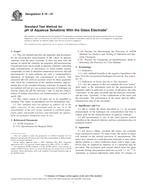Potřebujeme váš souhlas k využití jednotlivých dat, aby se vám mimo jiné mohly ukazovat informace týkající se vašich zájmů. Souhlas udělíte kliknutím na tlačítko „OK“.
ASTM D5996-05(2009)
Standard Test Method for Measuring Anionic Contaminants in High-Purity Water by On-Line Ion Chromatography
Automaticky přeložený název:
Standardní zkušební metoda pro měření aniontových kontaminujících látek v vysoce čisté vody pomocí ON-LINE iontovou chromatografií
NORMA vydána dne 1.10.2009
Informace o normě:
Označení normy: ASTM D5996-05(2009)
Poznámka: NEPLATNÁ
Datum vydání normy: 1.10.2009
Kód zboží: NS-33362
Počet stran: 6
Přibližná hmotnost: 18 g (0.04 liber)
Země: Americká technická norma
Kategorie: Technické normy ASTM
Kategorie - podobné normy:
Anotace textu normy ASTM D5996-05(2009) :
Keywords:
anions, high purity, ion chromatography, on-line, Acetate concentration, Anionic contamination, Chloride analysis--water applications, Contamination--water, Fluoride (ion) analysis, Formate, High-purity water, Ion chromatography (IC), Nitrate (ion) analysis, Online monitoring (in water analysis), Phosphate content--water applications, Sulfate content--water, ICS Number Code 71.040.50 (Physicochemical methods of analysis)
Doplňující informace
| Significance and Use | ||||||||||||||||||||||
|
In the power-generation industry, high-purity water is used to reduce corrosion from anions, such as sulfate, chloride, and fluoride. These anions are known to be detrimental to materials of construction used in steam generators, reactor vessel internals and recirculation piping, heat exchangers, connective piping, and turbines. Most electric generating plants try to control these anions to <1.0 μg/L in the steam generator feed water. Some nuclear power plants have been able to control anion contaminants at less than 0.02 μg/L. These anions and others cause low product yields in semiconductor manufacturing. They are also monitored and controlled at similarly low levels as in the electric power industry. Low molecular weight organic acids (acetate, formate, propionate) have been detected in steam generator feed water. These low molecular weight organic materials are believed to be high-temperature degradation products of chemicals used to control cycle water pH and organic contaminants in cycle makeup water. In the semiconductor industry, anion contaminants may come from the breakdown of low molecular weight organic materials by ultraviolet light radiation, which is frequently used to produce bacteria-free water. These organic compounds may also contribute to low product yield. The production of high-purity water for process makeup and use frequently employs the use of demineralizers to remove unwanted anion contaminants. Also in the electric power industry, demineralizers are used in the process stream to maintain low levels of these contaminants. As such, it is important to monitor this process to ensure that water quality standards are being met. These processes can be monitored for the above-mentioned anions. On-line measurements of these contaminants provide a greater degree of protection of the processes by allowing for frequent on-line measurement of these species. Early detection of contaminant ingress allows for quicker corrective action to locate, reduce, or eliminate, or combination thereof, the source. Grab samples will not provide the same level of protection because of their intermittent nature and the longer time required to obtain and then analyze the sample. Additionally, on-line monitoring significantly reduces the potential for contamination of high-purity water samples, a significant problem when sampling and testing high-purity water. |
||||||||||||||||||||||
| 1. Scope | ||||||||||||||||||||||
|
1.1 This test method covers on-line analysis of high-purity water by the ion chromatography technique. This test method is applicable for measuring various anionic contaminants in high-purity water, typically in the range of 0.01 to 100 μg/L. This test method is used to determine the concentration of acetate, formate, chloride, fluoride, phosphate, nitrate, and sulfate in a continuously flowing sample. The range of the test method is only as good as the reagent water available for preparing standards. At extremely low concentrations, <1.0 μg/L, preparing standards is difficult, and extra care must be taken in their preparation. The sample may have to be conditioned from higher pressures and temperatures to conditions that are suitable for use by on-line instruments. 1.2 Online sample analysis of flowing streams does not lend itself to collaborative studies due to the nature of the sample and the possibility of contamination that may result from handling the sample as part of the collaborative study. Therefore this standard test method is not based on the results of a collaborative study but is intended to provide the best possible guidance for doing this type of analysis. 1.3 This standard does not purport to address all of the safety concerns, if any, associated with its use. It is the responsibility of the user of this standard to establish appropriate safety and health practices and determine the applicability of regulatory limitations prior to use. |
||||||||||||||||||||||
| 2. Referenced Documents | ||||||||||||||||||||||
|
Podobné normy:
Historická
1.4.2007
Historická
1.10.2008
Historická
1.1.2013
Historická
1.5.2014
Historická
1.11.2012
Historická
15.6.2008



 ASTM E70-07
ASTM E70-07 ASTM E827-08
ASTM E827-08 ASTM E840-95(2013)..
ASTM E840-95(2013).. ASTM E925-09(2014)..
ASTM E925-09(2014).. ASTM E984-12
ASTM E984-12 ASTM F1710-08
ASTM F1710-08
 Cookies
Cookies
